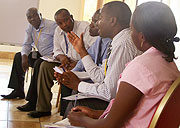“Influenza pandemics, whether moderate or severe are remarkable events because of the universal susceptibility of the world’s population to infection. We are all in this together.”


"Influenza pandemics, whether moderate or severe are remarkable events because of the universal susceptibility of the world’s population to infection. We are all in this together.”
This was the sombre warning as the World Health Organisation (WHO) announced the beginning of the Swine Flu pandemic in June.
The crisis has since escalated; the UK makes harrowing estimates of 100,000 new cases daily this August, whilst the WHO has warned as many as 2 billion people could succumb to Swine Flu.
The virus has jumped the species barrier and is tearing through populations, with the WHO’s member countries ‘nearing 100% infection’, including the East African Community.
Rwanda remains in the select group who have resisted the onslaught. However, Dr Jackson Sebeza, head of the TRAC plus unit concerned with outbreaks of epidemics, told The New Times that, "the likelihood of the virus coming to Rwanda is very high.” The authorities are preparing for an outbreak.
The Swine Flu virus was born in the torrid Mexican pig farms; the concerns were raised as the virus was contracted by humans, and eventually spread between humans. Its effects are similar to seasonal bouts of influenza, with many shaking off the virus with tissues at home.
The 1126 deaths that have been recorded were predominantly in people with existent health problems.
It is not, however, current incidence and deaths that determine the preparations of far sighted states. Dr Sebeza considers Swine Flu, despite its absence, the largest health priority for the government and he currently reports on behalf of TRAC plus to the Minister of Health on a near daily basis.
The government’s measures are in part a result of an obligation to the international community, to assist tracking as they attempt to halt the spread of the virus.
However, this couples with the potential for the flu to infect huge numbers of the population and to mutate, like the 1918 pandemic, becoming far more deadly. These fears guide the government preparations.
Rwanda officially has no cases although WHO official, Mr Fukuda, warns that, "official figures are a subset of real numbers.” Concerns exist that identification is limited by inadequate detection measures. Dr Sebeza however is resolute on the issue, "I can be sure that we do not have swine flu.”
This is a judgement supported by Rwanda’s unique place amongst lower resource nations to be able to register the virus.
There are six sentinel sites with the capacity for identification, covering all provinces. These sites, constructed during the deadly H5N1 Avian flu, take random samples daily from symptomatic patients.
This is combined with influenza figures matching previous years, showing no heightened outbreak. As a result the government is working first to prevent the arrival of the flu.
"We are expecting the virus to arrive from the outside. The mobilisation has therefore taken place at entry points, although missing some cases is possible,” Dr Sebeza lamented.
Passengers arriving at Kanombe airport - the most likely entry point for the virus - have been given questionnaires, and rapid response teams have been organised. Other borders have information and designated district hospitals to deal with any outbreak.
The WHO does not recommend bans on international travel, but this leaves Rwanda exposed.
The information from travellers is not reliable especially if symptoms have not developed. Equally, in my experience at a Rwandan border, albeit after a 10 hour bus journey, I missed all warnings of Swine Flu.
These measures are important but limited, it is the reaction of the people and authorities when an outbreak is reported which will determine Rwanda’s defences.
The approach to restricting the spread of the virus is based on three principles, surveillance, case management and communication, incorporated into the ‘Emergency Operations Plan’.
The report, released by TRAC plus, was discussed on Monday and Tuesday by international organisations, government officials and clinicians. "The purpose of this conference is to determine where we are weak and what our strengths are and then work on the plan”, said Anicet Nyawakira, from the Ministry of Health.
The preparations include stockpiling of 14, 256 doses of Tamiflu (antiviral), the training of 4 – 6 doctors in all of the major district hospitals in epidemic procedure with isolated rooms to limit the spread of the virus, as well as a hotline for the concerned public, amongst others.
However, these plans are guided by a restricted budget. Tamiflu stocks depend on calculations for the first outbreaks. Dr Sebeza cautioned saying, "we are not the UK, who have stocked approximately 50 million doses of the antiviral. we can’t afford to use these resources when we don’t have a single case.”
The emergency plans instead, hopes to by-pass bureaucracy and attain supplies rapidly in case of a major outbreak.
One concern over the adequacy of preparation is public information; action of the public, such as reporting influenza symptoms, good hygiene and cooperation in containment measures are crucial to containing the virus.
TRAC plus believe public information is sufficient, however after asking a group of socially aware students – in three languages – the response was of confused faces.
Indeed, there is more exposure to Rwandatel than the Swine Flu crisis. The Emergency plans allow for public information but exposure is needed immediately, an important concern to be addressed.
The government is well prepared for the absent flu, robust methodology and mobilisation of human and material resources puts Rwanda in a strong position.
Mr Fukuda from the WHO however warns that "it is impossible to predict what the future will hold.”
We stand at the beginning of an epidemic; the government cannot prevent the virus from arriving and equally cannot prevent it from changing, their action is prudent but the path of the virus is unpredictable.
Contact: philiprushworth89@hotmail.com


